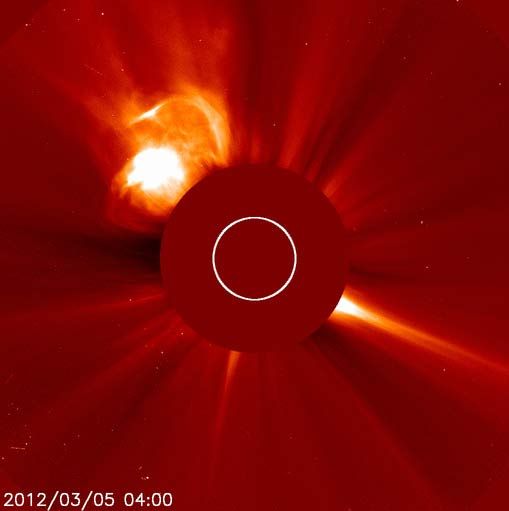Sun Erupts With Major Solar Flare

A major solar flare erupted from the sun late last night (March 4) sending an explosion of plasma and charged particles hurtling toward Earth.
The flare was an X1.1-class solar flare and exploded from the surface of the sun at 11:13 p.m. EST (0413 GMT March 5), according to the Space Weather Prediction Center operated by the National Weather Service.
X-class flares are the most powerful type of solar storm, with M-class eruptions falling within the mid-range, and C-class flares being the weakest.
The X-class flare unleashed a wave of plasma and charged particles, called a coronal mass ejection (CME), into space.
"The expanding cloud will probably deliver a glancing blow to Earth's magnetic field on March 6th or 7th," the website Spaceweather.com reported in an alert. "High-latitude sky watchers should be alert for auroras in the nights ahead." Spaceweather.com regularly monitors solar storms and skywatching events.
Several spacecraft, including NASA's Solar Dynamics Observatory and the Solar Heliospheric Observatory (SOHO), observed the extreme ultraviolet flash from the flare.
This latest solar flare is the second X-class sun storm of 2012. The first event occurred on Jan. 27 and registered as an X1.7 on the space weather scale used by astronomers.
Sign up for the Live Science daily newsletter now
Get the world’s most fascinating discoveries delivered straight to your inbox.
When a powerful X-class flare is aimed directly at Earth, it can sometimes cause significant disruptions to satellites in space and power grids and communications infrastructure on the ground. Strong flares and CMEs can also pose potential hazards to astronauts on the International Space Station.
These radiation storms can also amp up normal aurora displays (also called the northern and southern lights) for lucky skywatchers at high latitudes.
Last night's solar flare burst from a big sunspot region called AR1429, which has been particularly active since it materialized on March 2. This same region produced an M2-class eruption yesterday, which also triggered a CME that is currently approaching Earth and could deliver a glancing blow tonight at around 11:30 p.m. EST (0430 GMT Tuesday, March 6).
As a result, when the CME from last night's X-class flare arrives at Earth over the next day or two, the planet might already be in the midst of a geomagnetic storm, according to Spaceweather.com.
The sun's activity ebbs and flows in an 11-year cycle. Currently, the sun is in the midst of Solar Cycle 24, and activity is expected to ramp up toward the solar maximum in 2013.
This story was provided by SPACE.com, a sister site to LiveScience. Follow SPACE.com for the latest in space science and exploration news on Twitter @Spacedotcom and on Facebook.














